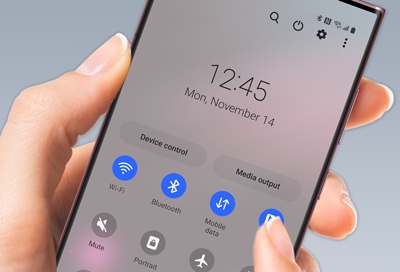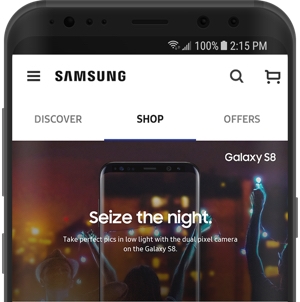Manage data usage on your Galaxy phone

Manage data usage on your Galaxy phone
Manage data usage

Do you know where your data is? Track your data usage to make sure you never run out.
Navigate to and open Settings, then tap Connections, and then tap Data usage to view your Mobile data usage or Wi-Fi data usage.
The options may be slightly different depending on what carrier you have, but here are the general settings you can adjust from this page.
- Data saver: Helps cut down your data usage by preventing apps from using data in the background.
- Allowed networks for apps: Set whether apps should use Wi-Fi only, mobile data, or whichever one is available.
- Mobile data: Access the internet through your mobile network. You can turn mobile data on or off by tapping the switch.
- Mobile data usage: Get a more detailed breakdown of your data usage, such as which apps use the most data.
- Billing cycle and data warning: Set limits or warnings to make sure you don't overuse your data. Please see the section titled "Data billing cycle settings."
Note: You can also contact your carrier to check your daily data usage. Many carriers provide a text message service that allows you to send specific keywords, such as "Data," to a designated number to receive a text with your current data usage. - Wi-Fi data usage: Get a more detailed breakdown of your Wi-Fi usage, such as which apps use Wi-Fi the most.
Set and manage mobile data limit
Managing a data limit on your Galaxy phone can help you stay within your plan and avoid unexpected charges or speed reduction (data throttling) when your data limit is reached.
- Navigate to and open Settings, tap Connections, and then tap Data usage.
- Tap Mobile data usage, and then tap the Settings icon (it looks like a gear) at the top of the screen.
- Tap Start billing cycle on, select the start date that matches your billing cycle, and then tap Set.
- Turn on the switch next to Set data limit, then tap Data limit and enter the amount of data you want to set as your limit. Tap Set to save.
- To be alerted before reaching your full limit, turn on the switch next to Set data warning, then tap Data warning and enter the total data warning limit. Tap Set to save.
Turn Data saver on or off
Data saver prevents some apps from sending or receiving data in the background. So rest assured, you're not wasting any precious data.

- Navigate to and open Settings, and then tap Connections.
- Tap Data usage, tap Data saver, and then tap the switch next to Turn on now.
- If there are still some apps you'd like to run in the background, you can set them as exceptions. Tap Allowed to use data while Data saver is on at the bottom of the screen.
- Tap More options (the three vertical dots) and choose Show system apps or Show allowed apps first to narrow down the list.
- Finally, tap the switch(es) next to your desired app(s).
Data billing cycle settings

Another weapon in your arsenal is the Data usage settings. This will tell you when you're nearing the end of your billing cycle and warn you when data is running low.
Navigate to and open Settings, tap Connections, and then tap Data usage. Tap Billing cycle and data warning, and then check out the following settings:
- Start billing cycle on: Set the date when your billing cycle starts to keep track of your mobile data usage.
- Set data warning: Turn the data warning feature on or off by tapping the switch.
- Data warning: Set the amount of data to use before receiving a warning about your usage.
- Limit mobile data usage: Turn the limit mobile data feature on or off by tapping the switch.
Note: With some carriers, this feature may be called Set data limit. - Data limit: Set the amount of data you can use before mobile data is disabled.
Data roaming
If you leave your carrier's coverage area, you may still be able to access mobile data by enabling Data roaming. Most carriers work together to allow you to connect to other networks, even outside of the United States.

Before you turn on Data roaming, please be aware that there may be additional charges from your carrier, especially outside of the country. Contact your carrier for details before enabling Data roaming.
To turn it on:
- Navigate to and open Settings.
- Tap Connections, and then tap Mobile networks.
- Tap the switch next to Data Roaming Access to enable or disable the feature.
Mobile data usage troubleshooting
Check for obstacles and interference
Check the SIM card or eSIM
- First, power off your phone. Swipe down from the top right corner of the screen twice, and then tap the Power icon. Tap Power off, and then tap Power off again.
- Next, insert the ejector tool that came with your phone into the hole on the SIM card tray. Push the tool until the tray pops out.
Important: Be careful not to insert the ejector tool into any of the microphone or speaker holes along the edge of your phone. - Remove the SIM card and inspect it for damage or corrosion. Reinsert the SIM card, making sure it is properly installed in the tray.
- On most models, the SIM card should be placed in the tray with the gold-colored contact facing upwards.
Note: If you insert the tray into the slot while the SIM card is placed improperly, the SIM card may not be recognized. - Reinsert the SIM tray into the slot on your phone.
- Now, press the Power button to turn on your phone.
- Navigate to and open Settings, and then tap Connections. Tap SIM manager, and make sure the switch next to your active SIM card (SIM 1) is turned on.
You can check out our guide to make sure you are removing and inserting the SIM card correctly.
eSIM (embedded SIM):
- Navigate to and open Settings, and then tap Connections.
- Tap SIM manager. From here, make sure the switch next to your activated eSIM is enabled.
- You can also tap Primary SIM to change the default connection for making calls, sending texts, and using data.
You can check out our guide to learn more about using the eSIM.
Check the data usage settings
- Navigate to and open Settings, and then tap Connections.
- Tap Data usage, and then make sure the switch next to Mobile data is turned on.
- Tap Mobile data usage and check your data usage settings to ensure no apps are consuming excessive data in the background. Tap an app from the list, and then turn off the switch next to Allow background data usage.
- Tap the Back button twice, and then tap Data saver. Turn off the switch next to Turn on now. Or, tap Apps that can always use data, and then turn on the switch next to the apps you want to always use data.
- Tap the Back button once, and then tap Billing cycle and data warning, and then turn off the switch next to Set data limit.
- Tap the Back button once, and then tap Allowed networks for apps. Tap an app, and select Mobile data or Wi-Fi, Wi-Fi only, or Mobile data preferred.
Check the Mobile network settings
Verify that your phone is connected to the correct network.
- Navigate to and open Settings, and then tap Connections.
- Tap Mobile networks, then tap Access Point Names and verify that you're connected to the correct network carrier.
- Tap the Back button once, then tap Network operators. Make sure the switch next to Select automatically is turned on.
If you're unsure about the required Mobile networks or Network operators, contact your carrier for further assistance.
Restart your phone
- Swipe down from the top right corner of the screen twice to expand the Quick panel.
- Tap the Power icon, and then tap Restart. Tap Restart again.
Check for software updates
- Navigate to and open Settings.
- Swipe to and tap Software update or System updates. It will vary between models.
- Then, tap Download and install, Check for system updates, or Check for new updates, depending on your carrier.
- If an update is available, it should begin downloading automatically, although you may need to tap Download now on some phones.
- Once the download is complete, follow the on-screen instructions to install the update.
Reset the mobile network
- Navigate to and open Settings, and then swipe to and tap General management.
- Tap Reset, and then tap Reset mobile network settings.
- Tap Reset settings. You may be prompted to enter your security credentials. Tap Reset to confirm.
Contact your carrier
If the troubleshooting steps provided in this section did not resolve the mobile data usage issues your phone is experiencing, contact your carrier for further assistance.



Contact Samsung Support



